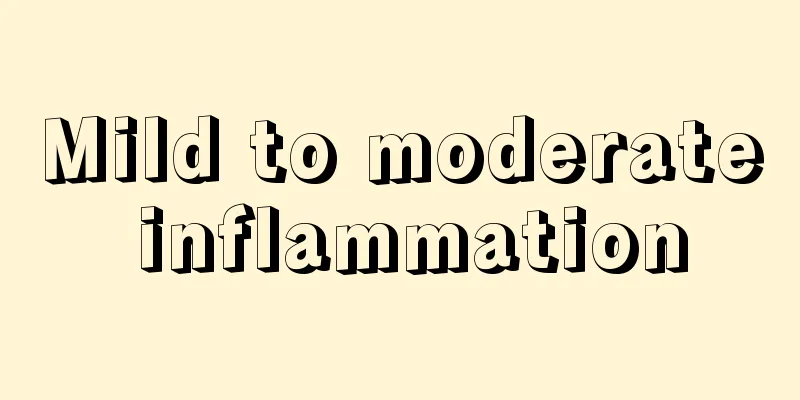Mild to moderate inflammation

|
Inflammation is an instinctive defense reaction of the human body to external stimuli. In medicine, redness, swelling, heat, pain and dysfunction are generally regarded as clinical manifestations of inflammation. Inflammation can also be summarized as what we often call "inflammation". Sometimes inflammation can help the body eliminate bacteria, but some inflammation is harmful to the body and can be life-threatening in severe cases. This article introduces the details about inflammation. Let’s learn about it together. 1. The defensive response of living tissues with vascular systems to damaging factors is inflammation. Vascular responses are central to the inflammatory process. Inflammation, which is what people usually call "inflammation", is a defensive response of the body to stimulation, which manifests as redness, swelling, heat, pain and dysfunction. Inflammation can be infectious inflammation caused by infection or non-infectious inflammation not caused by infection. Normally, inflammation is beneficial and is the body's automatic defense response, but sometimes, inflammation can be harmful, such as attacks on the body's own tissues, inflammation occurring in transparent tissues, and so on. Inflammation is a very common and important basic pathological process. Traumatic infections on the body surface and most common and frequently occurring diseases of various organs (such as furuncle, carbuncle, pneumonia, hepatitis, nephritis, etc.) are all inflammatory diseases. The defensive response of living tissues with a vascular system to damaging factors is called inflammation. Any factor that can cause tissue damage can be a cause of inflammation, that is, an inflammatory agent. They can be grouped into the following categories: 1. Biological factors Bacteria, viruses, rickettsia, mycoplasma, fungi, spirochetes and parasites are the most common causes of inflammation. Inflammation caused by biological pathogens is also called infection. Exotoxins and endotoxins produced by bacteria can directly damage tissues; viruses replicate in infected cells, causing cell necrosis; certain antigenic pathogens damage tissues by inducing immune responses after infection, such as parasitic infections and tuberculosis. 2. Physical factors High temperature, low temperature, radioactive substances, ultraviolet rays, and mechanical damage. 3. Chemical factors Exogenous chemicals such as strong acids, strong alkalis, turpentine, mustard gas, etc. Endogenous toxic substances such as decomposition products of necrotic tissue and metabolic products that accumulate in the body under certain pathological conditions, such as urea. (IV) Foreign matter Foreign objects that enter the human body through various pathways, such as various metals, wood debris, dust particles, and surgical sutures, can cause varying degrees of inflammatory responses due to their different antigenicity. (V) Necrotic tissue Ischemia or hypoxia can cause tissue necrosis, which is a potential inflammatory factor. The congested hemorrhagic bands and infiltration of inflammatory cells at the edge of fresh infarction are manifestations of inflammation. (VI) Allergic reaction When the body's immune response is abnormal, it can cause inappropriate or excessive immune responses, resulting in tissue and cell damage and leading to inflammation. Tissue damage caused by immune response is most common in various types of hypersensitivity reactions: type I allergic reactions such as allergic rhinitis and urticaria, type II allergic reactions such as anti-basement membrane glomerulonephritis, type III allergic reactions such as glomerulonephritis caused by immune complex deposition, type IV allergic reactions such as tuberculosis and typhoid fever; in addition, there are many autoimmune diseases such as lymphocytic thyroiditis and ulcerative colitis. |
<<: Wash your hair with ginger and vinegar
>>: Can bacteria die from exposure to the sun?
Recommend
Is vinegar soaked black beans effective in removing freckles?
As people in modern society pay more and more att...
Symptoms of conch poisoning
You must be careful when eating conch. Eating too...
Common metastasis patterns of laryngeal cancer
The main ways of metastasis of laryngeal cancer i...
How often does a 6 month old baby poop?
If there is a baby at home, the whole family will...
Ultrasound diagnostic manifestations of renal cancer
The ultrasound manifestations of renal cancer wer...
How to exercise brain power and memory
The brain is the most complex structure in the hu...
Dietary principles for kidney cancer patients
Food, nutrition and other factors are closely rel...
How to plant watermelon seeds after eating
Many people choose to save the watermelon seeds w...
5 black hours of air conditioning poisoning
Many drivers don’t know that there are 5 “black t...
How to treat gastric mucosal prolapse
Gastric mucosal prolapse is a very serious diseas...
How should family members care for a patient with intestinal cancer
Colorectal cancer is a common disease that affect...
What to do if rectal cancer has lymph node metastasis in the late stage?
In the late stage of rectal cancer, there are oft...
What are the common manifestations of herpes simplex
Herpes simplex often invades the human skin and m...
What are the causes of liver cancer
Liver cancer is a highly hidden malignant tumor. ...
What are the new models for lung cancer treatment? This treatment of lung cancer can significantly improve the effect
How lobectomy treats lung cancer The choice of lu...









